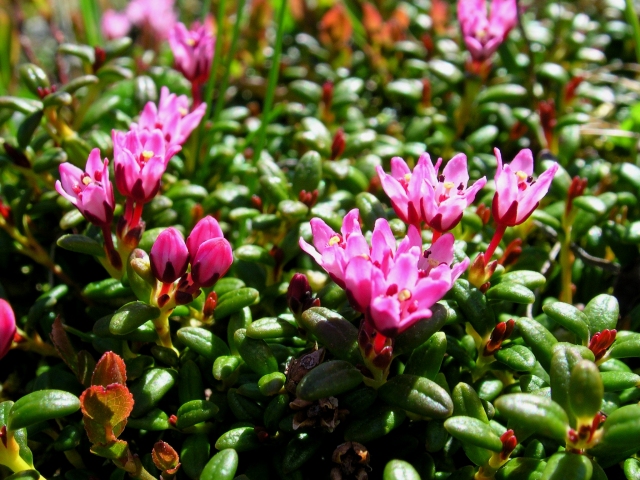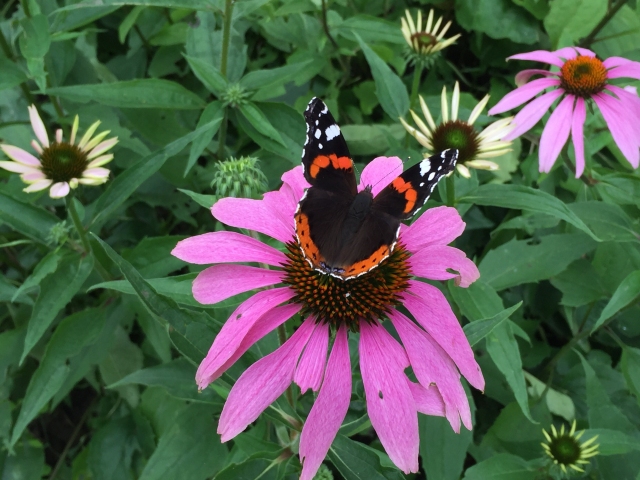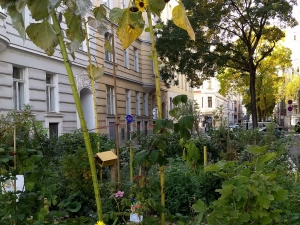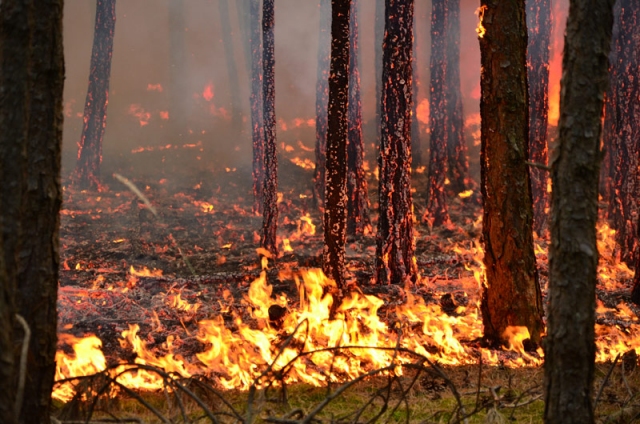
Florian Heigl
Categories to come
What is the project specifically about?
So much hangs on just one thing - and yet words sometimes fail us. How do we talk about our bodies and the things that we need, want, and do when it comes to sex and sexual pleasure? And who do we talk to about these things? Categories to Come invites everybody to put their sexuality into words, and to discuss new words or new uses of words with other people. Goal of the project is to create a platform and gather resources, that open up so far unnamed subject areas of sexuality. They will be accessible both for personal gain and interdisciplinary research.
How can citizens participate in research?
Citizens are actively involved in shaping the future vocabulary of sexual language and provide important impulses for research. Citizens can write down their own terms and descriptions for intimate activities and their own sexual desire. They can also collect and name passages from songs, books or films that are sexually interesting to them. They can look at films and photos and other cultural works and describe what can be seen there and index them. They can read books and texts and filter out places with sexual acts and tag them.
What happens to the results?
The results form a resource to illustrate previously unnamed areas of sexuality. This data collection will be organized and made available as a database and can be used to enhance studies by researchers working in linguistics, social sciences, sexology, gender studies and literature as well as for art production.
What does the research contribute to?
Categories to come helps to build a new resource for research on sexuality in different disciplines. The project is based on two assumptions, namely, 1) the existing sexual vocabulary has only been partly described, and 2) because of sexuality’s visual nature, lack of language, and location within the realm of experience, there are many fantasies and sex acts that nobody has yet attempted to put into words. The project Categories to Come combines artistic and academic research interests. In contrast to purely scientific research, the artistic element also allows one to become creative and to create new words. Categories to come thus contributes to making research into sexual language and sexual desire more diverse.
This project shows what the artistic aspect can be in a research context, how it produces a different kind of knowledge than purely scientific research and how this can make a contribution in an interdisciplinary context. By making the results publicly accessible, citizens can use the database themselves and find new ways and terms to talk about sexuality. This counteracts tabooing and promotes a conscious discussion of one's own sexuality.
Image gallery
-
 "so much revolves around this one topic" "so much revolves around this one topic"
"so much revolves around this one topic" "so much revolves around this one topic" -
 "and still we sometimes miss words" "and still we sometimes miss words"
"and still we sometimes miss words" "and still we sometimes miss words" -
 Facebook header of the project Facebook header of the project
Facebook header of the project Facebook header of the project
https://www.citizen-science.at/en/immerse/worldwide/author/934-florianheigl?start=130#sigProId8680991c3e
Nature conservation monitoring
We take care of our meadows and alpine pastures!
For more than a decade, hundreds of farmers have been saying "We look at our meadows and alpine pastures!".
The regular observations of the more than 700 participants impressively show that on more than 80 % of the monitoring plots in extensive grassland the number of individuals of the species observed has remained the same or even increased.
By observing the animals and plants every year, the perspective with which the farmers perceive their meadow changes and a process of more conscious action is set in motion.
Background
In monitoring extensive grassland, participants look at which management practices promote or inhibit the occurrence of individual plant and animal species.
The Austria-wide observations of plant and animal diversity provide new insights into the benefits of management in extensive grassland. (By extensive grassland we mean species-rich meadows that are mowed a maximum of two to three times a year or not at all or only slightly fertilized and gentle grazing.)
The species-rich grassland has been displaced by a frightening 90% since the 1960s due to structural changes in agriculture and land use change! The last occurrences of colorful flower meadows are therefore landscapes with a high number of species and important retreat areas for plant and animal diversity in Austria!
By regularly observing the development of indicator species, the meaning of different agri-environmental measures (ÖPUL) such as contractual nature conservation, organic farming (BIO) and environmentally friendly and biodiversity-promoting management (UBB) is made understandable and it is observed at farm level whether agricultural subsidies also have an effect on the area.
The nature conservation monitoring will show which type of management is well suited for the type of meadow under consideration and therefore leads to safe stocks of the observed indicator species. As a result, management requirements can be better evaluated on the basis of feedback from farmers and funding can be awarded in a targeted manner.
Participate
All farmers with (potentially) extensive meadows and pastures who take part in the agri-environmental measure ÖPUL “Organic farming (BIO)” or “Environmentally friendly and biodiversity-promoting management (UBB)” can take part. At the beginning there is an enrollment by an ecologist. It is agreed which indicator species are to be observed and counted annually. The participants then document the indicator species and the management of the meadow every year and enter the data on the online platform www.naturschutzmonitoring.at.
Project duration: until 2029
Information on participation:
- Hotline: +43 677 643 130 71
- Mail: This email address is being protected from spambots. You need JavaScript enabled to view it.
Quotations of participants
„This year I deliberately left a patch of rambling bellflowers so that they could sow seeds. Now I am already curious whether they will be more next year!“
„This project is going places. My son wanted to reforest our rough pasture some time ago, because the fodder is worth nothing and mowing takes a lot of time. Since your expert showed him that there are a lot of rare animals and plants living in it, he hasn't said anything about it. He even helps me counting now.“
„What makes me particularly happy is that for once it is not about control or money, but about seeing and appreciating the beautiful aspects of our work.“
You can also follow the ÖKL on Facebook, Instagram and YouTube for further information.
Project management
Barbara Steurer
Österreichisches Kuratorium für Landtechnik und Landentwicklung (ÖKL)
Gußhausstraße 6
1040 Wien, Austria
www.oekl.at
https://www.citizen-science.at/en/immerse/worldwide/author/934-florianheigl?start=130#sigProIddb6afa55fd
BeeRadar
We are tracing the Sculptured Resin Bee!
Home of the Sculptured Resin Bee (Megachile sculpturalis, Smith 1853) is far away in Japan, China, Korea and Taiwan. In 2008, the Sculptured Resin Bee was discovered in southern France as the first introduced wild bee species in Europe. Since then, the bee has been particularly active and dispersed rapidly throughout Europe. Together, we track down the Sculptured Resin Bee in Austria.
Report your observations via email at This email address is being protected from spambots. You need JavaScript enabled to view it. or on Instagram.

You can also scan this QR-Code to go directly to the website:
The look of the Asian bee is remarkable
The sculptured resin bee has a unique appearance:

© Felix Fornoff 2020
Where you can find the Sculptured Resin Bee
The sculptured resin bee nests in cavities in dead wood. They often inhabit artificial nesting sites, so-called "bee hotels". There, the females build nests and take care of their offspring. Such aids are necessary since it cannot drill holes in the wood on its own, even though the body size and powerful jaws might lead you to believe otherwise.
https://www.citizen-science.at/en/immerse/worldwide/author/934-florianheigl?start=130#sigProIddb4e59b282
Females prefer to collect pollen from exotic plants, which were frequently introduced in Central Europe as ornamental trees and shrubs. These ornamental plants decorate gardens and parks, such as the Japanese pagoda tree (Styphnolobium japonicum). As source of nectar, the sculptured resin bee often seeks out lavender or wisteria. Males of the Sculptured Resin Bee emerge earlier than females in the End of June until mid-July. Females appear a few weeks later and are active until about mid-September.
https://www.citizen-science.at/en/immerse/worldwide/author/934-florianheigl?start=130#sigProIdbf4d44bd56
Introduced is not invasive
The sculptured resin bee is the first and so far, only invasive wild bee in Europe.
Citizen Scientists of this particular project provided important insights into the competitive behavior against native bees. Participants reported observations where females of the sculptured resin bee were evacuating preoccupied nests of native bees. Once they cleared out larvae and pupae, these females used the nests for their own offspring. Based on these observations combined with a recent study from France, the sculptured resin bee has to be considered as an invasive species.
Not every introduced species is per se a severe threat for native biodiversity. Every new species needs to be monitored closely in terms of potential consequences for its new environment. But if negative impacts are observable, the species must be considered as invasive.
Project aims
The monitoring program aims to locate the sculptured resin bee in Europe. We examine its rapid dispersal behavior, investigate its preferences in regard to plant and nesting site selection and to reconstruct its colonization history.
Additionally, we take a closer look at the genetics of the sculptured resin bee. With these lab studies we examine the bee’s immigration history. Based on our international network of experts, we aim answer various research questions like which microbiota colonizes the bee.
For more information, please watch our short clip:
This project also aims to sensitize the participants to the local fauna and get aware of wild bees and their protection. The citizen scientists get a feeling for the possible effects of intentionally and unintentionally introduced and invasive species. A new point of view is presented to the participants in regard to artificial nests and active interventions in ecological systems. Participants will be informed how simple actions can be taken to support wild bees and other insects. They will also become part of scientific processes and gain insight into research processes.
Our published results
Within the last few years, we studied the invasive bee together with our participants. We published the results in scientific articles by choosing Open Access Journals.
2020
The first results of the initiated citizen science monitoring program were published in 2020. Within only two years after starting the project, 111 new reports from Switzerland, Liechtenstein and Austria were recorded. The population progressed remarkably fast from year to year expanding its region geographically, but also ecologically. The distribution pattern indicates that Austria is situated in a rather young invasion stage so far. The article can be found here.
2021
We performed population genetic analyses including specimens collected in the framework of a citizen science project. The aim was to study the colonization history and investigate the degree of connectivity between bees across Europe. We detected multiple, independent introduction events of the species to the European continent. This article can be found here.
For us, it was a special pleasure to publish an article describing the distribution of the invasive bee in Austria together with a Citizen Scientist. For the journal „Beiträge zur Entomofaunistik“ we introduced the sculptured resin bee as a new bee species for Austria. To read this article, you can click here (German).
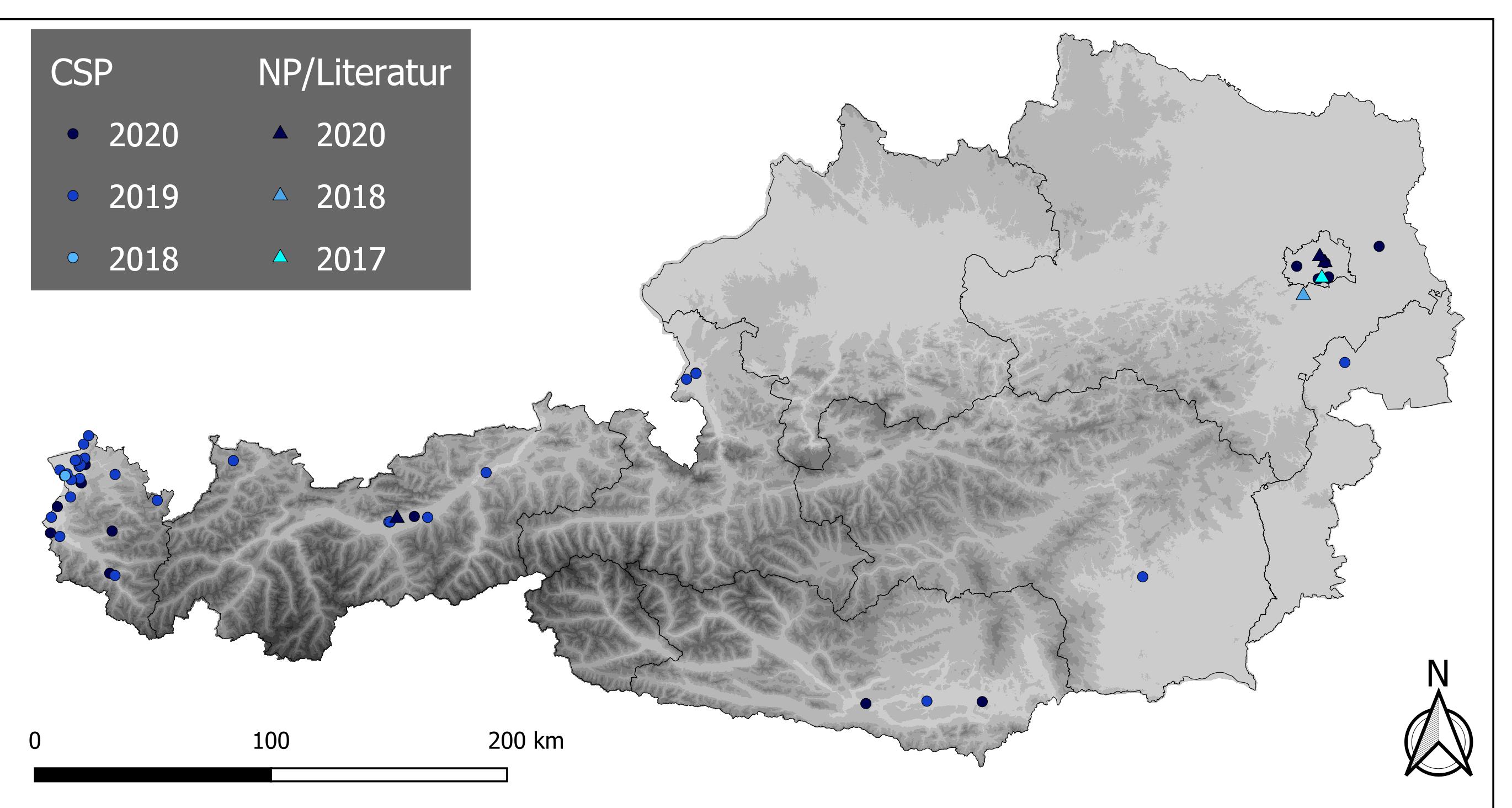 Spread of M. sculpturalis in Austria (2017-2020) © Lanner & Meyer 2020
Spread of M. sculpturalis in Austria (2017-2020) © Lanner & Meyer 2020
In a review published in the journal BeeWorld, we describe the main characteristics of the sculptured resin bee, its life cycle and its current distribution in colonised regions. We discuss possible ecological impacts on native bees. We also explore the role of beekeepers in monitoring projects and argue why they are valuable participants in citizen science projects.
The review is accessible here.
2022
BeeRadar launched an international study consisting of 19 authors from all over the world: USA, China, France, Italy, Serbia, and Austria. Using complex model calculations (species distribution modelling), we identified regions that are colonised by the sculptured resin bee, and influencing factors for its spread. Most of the data was collected with the support of the public. Man-made landscape structures, such as road networks, settlements and ports and airports, facilitate the spread of the Sculptured Resin bee. Click here for the article.

Even though citizen science has its momentum in many western regions, it is a less explored research practice in Eastern Europe. Together with our colleagues from the University of Belgrade, we initiated a first ecological-focused citizen science project in Serbia. We present the currently known distribution of the sculptured resin bee in the Balkans and discuss the potential and challenges of participatory research and intercultural science communication in Eastern Europe.

Podcast episode
Project leader Julia Lanner was a guest on an episode of the Österreich forscht podcast "Wissen macht Leute" in August 2022 - anyone interested in learning more about the project can listen to the episode here (in German).
Citizen Science Seminar
In 2021, poject coordinator Julia Lanner held a lecture about BeeRadar as part of the lecture series "Citizen Science Seminar" at the University of Natural Resources and Life Sciences Vienna (BOKU): "The making of 'Wanted - Asiatische Mörtelbiene'" (in German). At the end of this page you can watch the video recording of the lecture.
Project partners
- Inatura Erlebnis Naturschau GmbH
- Entomologische Verein Bern
- Naturschutzbund Österreich
- Naturbeobachtung.at
- Pollinature Beehome
Vielfalt bewegt! Alpenverein from young to old
This project of the Austrian Alpine Association - a biodiversity monitoring above the timberline - increases our knowledge about alpine animal and plant species, their habitats and about the interrelationships of our actions and the effects on this sensitive living environment. The collected data on the 20 animal and plant species contribute to scientific questions on biodiversity in the Alps.
Message
Which animals live and which plants grow in our mountains? Within the framework of "Vielfalt bewegt! Alpenverein from young to old" the Austrian Alpine Club investigates the most elevated habitats in Austria - a project for mountain enthusiasts and everyone who wants to become one!
This project overseen by the Austrian Alpine Club is planned as a long-term study and should contribute to the preservation and promotion of biological diversity in the Alps. Biodiversity monitoring in the highest habitats in Austria is intended to inspire people with an affinity for the mountains.
Like all citizen science projects, this project also depends on its voluntary helpers, who observe typical animal and plant species of the Alpine region over a longer period of time and condense and pass on their knowledge about the Alpine habitat.
Aims of the project
The purpose of monitoring is to develop appropriate measures on the basis of the knowledge gathered, which can reduce the decline of species and secure or improve habitats for endangered species in the long term. The consequences of climate change (migration of some species to higher regions or changes in food resources) can also be demonstrated in this way. On the one hand, distribution maps are to be generated to provide information on the occurrence of the individual species and, on the other hand, the data are to be made available for publications etc. on request.
The project offers mountaineers the opportunity to experience nature consciously and attentively again in contrast to summit attempt and pressure to perform.
The project "Vielfalt bewegt! Alpenverein from young to old" provides knowledge about alpine species and the connections to the conservation of biological diversity in alpine habitats in an age-appropriate form for children, youths, parents and grandparents. The pillar for the long-term continuation of the project idea is the intergenerational exchange about nature, its habitats and species. Parents and grandparents become multipliers. In the course of this, cooperation with "Alpenvereinsjugend", which has been active in education for sustainable development for a long time, is also strengthened.
-
 Alpine salamander Alpine salamander
Alpine salamander Alpine salamander -
 Small Apollo Small Apollo
Small Apollo Small Apollo -
 Mountain Arnica (Wolf's bane) Mountain Arnica (Wolf's bane)
Mountain Arnica (Wolf's bane) Mountain Arnica (Wolf's bane) -
 Alpine chough Alpine chough
Alpine chough Alpine chough -
 Mountain avens Mountain avens
Mountain avens Mountain avens -
 Identifying species Identifying species
Identifying species Identifying species -
 Alpine Azalea Alpine Azalea
Alpine Azalea Alpine Azalea -
 Identifying species II Identifying species II
Identifying species II Identifying species II -
 Identifying species III Identifying species III
Identifying species III Identifying species III -
 Spotted Nutcracker Spotted Nutcracker
Spotted Nutcracker Spotted Nutcracker
https://www.citizen-science.at/en/immerse/worldwide/author/934-florianheigl?start=130#sigProId5891ec5508
Procedure
Different indicator species, which have their habitat above the forest line, were selected on the basis of various criteria - including alpine ptarmigan, mountain avens, oak spider or mountain azalea.
Observations are made at any time and on any hike, as the whim takes you!
Compact identification guides for the selected plants and animals should make it easier for the observers to track down the species during their hikes. Exciting and informative stories serve as a reminder. Data from nature observation, such as geographical location, altitude, weather or a description of the habitat of the indicator species, can then be entered in clearly structured questionnaires. As a matter of principle, observations are only made along existing hiking trails in order to conserve flora and fauna.
To make monitoring a little easier, a handy mapping guide was designed that can easily be taken into the field in addition to the 20 revised identification guides. In the mapping guide, the monitoring is briefly introduced again and it is explained where, how and when the 20 species sought can best and most easily be found. Selected identification sheets as well as the mapping instructions can be downloaded at the bottom of this page. A continuously updated distribution map can be seen here. The nature diary presents 20 animal and plant species that are typical for the Alpine region and also describes many helpful tips and tricks for observing them.
To record the observations, you can either use the web portal "Diversity moves, Alpine Association" or the app of the project. You can take photos directly with your smartphone; your location is automatically determined by the GPS transmitter. This way, if the internet connection is up and running, the observation can be transmitted directly to the web portal. If there is no reception, the data is saved locally in the app and sent to the web portal as soon as a connection can be found again.
How can you participate?
To take part in "Diversity moves! Alpine Club from Young to Old", you can register for the project via the registration form on the website. As soon as the registration is completed, you will receive a confirmation from the project team and can get started right away.
Memo Game
Within the project "Diversity moves! Alpine Club from Young to Old" (Biodiversity Monitoring), a beautiful memo game with 32 pairs of cards has been created. The drawn illustrations show different alpine animal and plant species that have their habitat above the timberline. In the enclosed booklet, in addition to the game instructions, all species are explained and their special characteristics highlighted. Sustainably packaged in a handy cotton bag, the game takes up hardly any space.
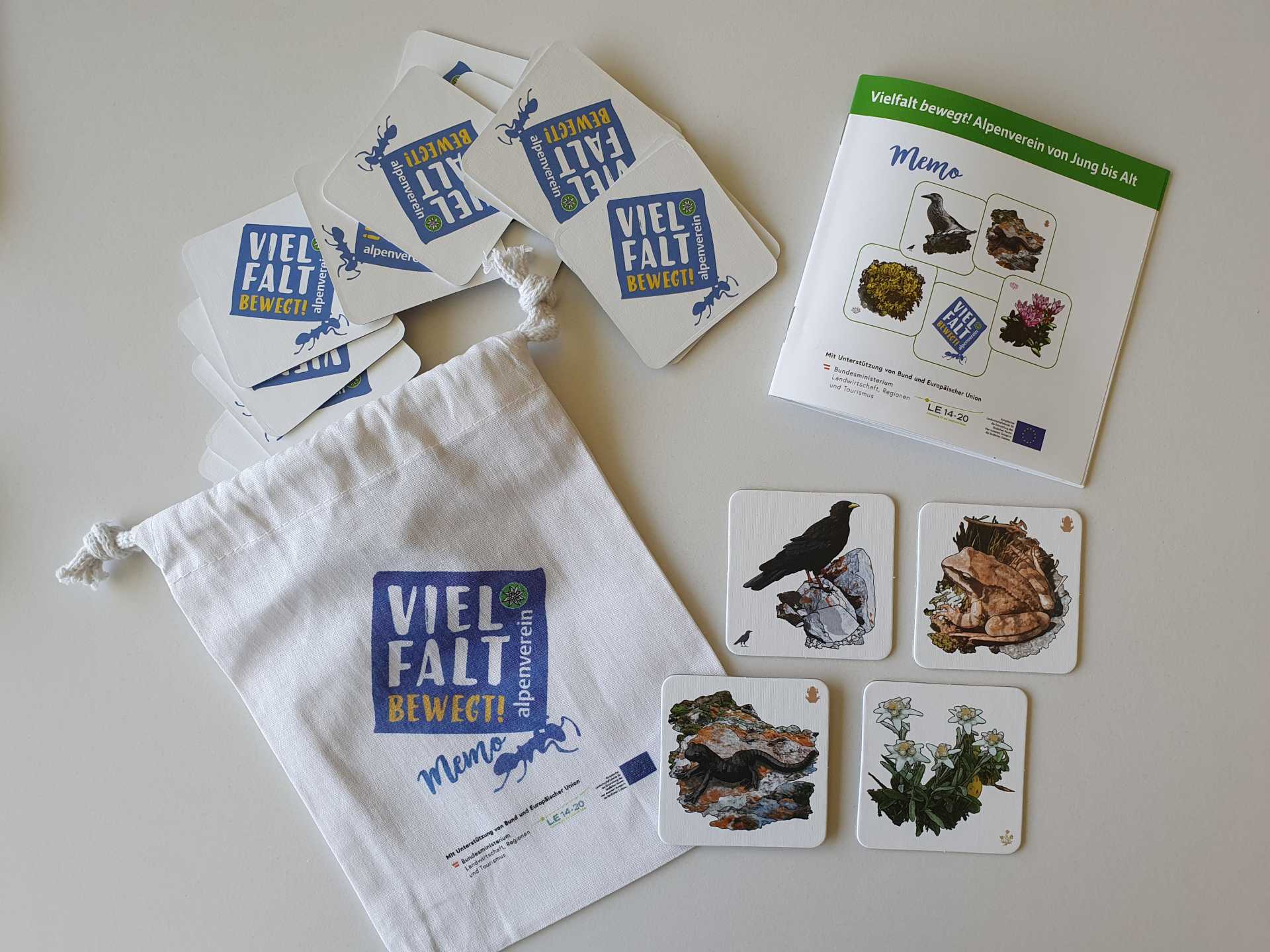
© Birgit Kantner
With the support of the federal government and the European Union within the framework of the implementation of the Austrian Programme for Rural Development 2014-2020.
Butterflies of Austria
App for the scientific recording of Austrian butterflies
On behalf of Blühendes Österreich - BILLA gemeinnützige Privatstiftunga, butterfly expert Peter Huemer published a report on the dramatic state of the butterfly fauna in May 2016. In Europe, their number had fallen by half since 1990 and over 50 percent of Austria’s butterflies are acutely threatened with extinction according to the Red Lists. Butterfly habitats have been massively restricted by agricultural intensification, increasing urban sprawl and the drastic loss of species-rich flower meadows in general, and their disappearance, which has received little public attaention to this date, ist described by experts as a clear indication of the imbalance in the entire ecosystem.
Every photo counts
The foundation Blühendes Österreich and the Lower Austrian environmental movement “Natur im Garten" are calling for Austria's first butterfly census with the "Schmetterlinge Österreichs" app.
Whether garden owner or park visitor, farmer, mountain lover or hiker or simply nature lover and butterfly fan - every Austrian can make a contribution to recording the population of Austrian butterflies as a citizen scientist: The app contains around 160 identifiable butterfly species and 32 moths and enables butterfly observations to be reported with just a few clicks and without complicated technical applications. Using an integrated photo function, photos are uploaded to a gallery within seconds and made available to the community and researchers.
Austrian butterfly gallery
Users contribute to the largest Austrian butterfly gallery with their sightings and photos. In less than a second after creating a photo and a sighting report, the data is put online in a gallery and can be shared and discussed with the butterfly community. The gallery is visible in a desktop version as well as on a smartphone. The passion, performance and commitment of each user is made visible and their reports are scientifically evaluated. Making the work of users visible is a major concern for Blühendes Österreich and “Natur im Garten”.
Identification forum
All butterfly lovers are invited to help users of the app with questions about identification or sightings. Blühendes Österreich and "Natur im Garten" seek to establish a lively and communicative butterfly forum with Austrian butterfly lovers. With the smartphone as a constant companion, the direct and simple connection to the community is given.
Citizen Science
By using the app and reporting sightings, each individual user contributes to the valuable recording of Austrian butterfly populations. Blühendes Österreich publishes the sightings as well as an annual evaluation (in cooperation with "Natur im Garten").
The proven experts Dr. Helmut Höttinger, Dr. Peter Huemer and DI Thomas Holzer have been recruited to provide scientific support and advice. Dr. Huemer is also on the board of the Blooming Austria Foundation.
Podcast episode (only available in German)
In November 2022, project coordinator Ines Lemberger was a guest on the Österreich forscht podcast "Wissen macht Leute" and provided many exciting insights into the project - you can listen to the episode here.
Citizen Science Seminar (only available in German)
Ronald Würflinger, secretary general of Blühendes Österreich, gave a lecture on "Austria's Butterflies" as part of the "Citizen Science Seminar" lecture series at BOKU University in 2022: "Of Power of Community, Butterflies and Open Data". You can watch the video recording of the lecture at the bottom of this page.
Austria's Butterflies on Social Media
Videos (only available in German)
Zeig her deinen Schmetterlingsgarten
2. Runde: Zeig' her deinen Schmetterlingsgarten 2018
Ausgeflattert II - im Burgenland, Niederösterreich, der Steiermark und in Wien
Ausgeflattert III - in Kärnten, Oberösterreich, Salzburg, Tirol und Vorarlberg
-
 Scarce swallowtail (Iphiclides podalirius) Scarce swallowtail (Iphiclides podalirius)
Scarce swallowtail (Iphiclides podalirius) Scarce swallowtail (Iphiclides podalirius) -
 Painted lady (Vanessa cardui) Painted lady (Vanessa cardui)
Painted lady (Vanessa cardui) Painted lady (Vanessa cardui) -
 Red admiral (Vanessa atalanta) Red admiral (Vanessa atalanta)
Red admiral (Vanessa atalanta) Red admiral (Vanessa atalanta) -
 Meadow brown (Maniola jurtina) Meadow brown (Maniola jurtina)
Meadow brown (Maniola jurtina) Meadow brown (Maniola jurtina) -
 European peacock European peacock
European peacock European peacock -
 Small white Small white
Small white Small white -
 Marbled white (Melanargia galathea) Marbled white (Melanargia galathea)
Marbled white (Melanargia galathea) Marbled white (Melanargia galathea) -
 Common brimstone (Gonepteryx rhamni) Common brimstone (Gonepteryx rhamni)
Common brimstone (Gonepteryx rhamni) Common brimstone (Gonepteryx rhamni) -
 Common blue butterfly (Polyommatus icarus) Common blue butterfly (Polyommatus icarus)
Common blue butterfly (Polyommatus icarus) Common blue butterfly (Polyommatus icarus) -
 Silver-washed fritillary (Argynnis paphia) Silver-washed fritillary (Argynnis paphia)
Silver-washed fritillary (Argynnis paphia) Silver-washed fritillary (Argynnis paphia) -
 Hipparchia hermione Hipparchia hermione
Hipparchia hermione Hipparchia hermione
https://www.citizen-science.at/en/immerse/worldwide/author/934-florianheigl?start=130#sigProIde7d646aceb
Blick ins Dickicht (A look into the undergrowth)
The “Blick ins Dickicht” project is dedicated to the search for the smallest native dormouse – the hazel dormouse. Until now, only very little has been known about this rare small animal. In order to learn more about its way of life and also how best protect it in working forests, evidence of hazel dormice is being sought in the Wienerwald forest and in the Donauauen national park. There are many different ways to participate here.
Where are hazel dormice found?
The hazel dormouse (Muscardinus avellanarius) is a type of rodent that lives in shrubs and bushes in the mixed forests of Northern, Central and Eastern Europe. Particularly important to this species is the availability of fruit-producing hedge plants and wood, such as hazelnut, brambles, honeysuckle, blackthorn and wild cherry.
A hidden lifestyle
The small, nocturnal dormouse is an omnivore. It eats, for example, seeds, buds and berries, as well as insects, small boneless animals and bird eggs. They are active from April to October, but hibernate during the winter months in nests that they build on the ground, often hidden under uprooted trees. Here, the hazel dormouse rolls into a ball and lowers its body temperature, heart rate and metabolism to a minimum.
Females have a litter of up to five once or twice a year and nurse them for around a month.
Hazel dormice are notably good climbers and are rarely on the ground during their active months.
Threats and protection
The hazel dormouse is protected in accordance with Annexe IV of the Fauna-Flora Habitat (FFH) guideline and is therefore among the most strictly protected species across Europe. The main cause of danger is loss of habitat and habitat fragmentation.
What are the goals of this project?
Due to the protection status according to Annexe IV of the FFH guideline, there is a reporting obligation in accordance with Article 17 of the FFH guideline. Despite this, Austria does not have any systematic categorisation and little is still known about the current state of the hazel dormouse. The goal of this project is therefore to improve the information base on the distribution, reproduction and population variations among dormice. Furthermore, the data that is gathered will also serve to coordinate management plans and silvicultural measures with considerations for the protection and growth of hazel dormouse populations.
How can I take part?
Opportunities for participation range from looking for traces of feeding on nuts to building and installing tracking tunnels to monitoring nesting boxes and thereby taking part in long-term monitoring of selected investigation areas of the Österreichischen Bundesforste in the Wienerwald Biosphere Reserve and National Park Donauauen.
Looking for traces of feeding on nuts
In autumn, you can find bitten seeds, from hazelnuts for example, under bushes and on the edge of forests. Traces of feeding left by dormice are very characteristic and therefore easy to identify. This method is thus ideally suited to providing evidence of the presence of hazel dormice, which is still unknown.
Building and installing tracking tunnels
These tracking tunnels, which are also easy for children to make, are installed in suitable places between ground level and chest height. Attracted by the bait, like some peanut butter, small animals such as hazel dormice will venture inside. Because the bait is placed on a mixture of cooking oil and activated charcoal, when leaving the tunnel, the animals will leave visible footprints on the paper strips. The footprints can then be used as proof.
Participating as a nesting box monitor
Nesting boxes that hazel dormice can use to build their nests will be installed in locations selected in advance by the project managers in the areas being investigated in Wienerwald Biosphere Reserve and National Park Donau-Auen. These nesting boxes will be observed by citizen scientists from April to October, during which time they will be checked in two-month intervals and inspected to see if there is a hazel dormouse inside.
Project management
Project manager for Wienerwald and Burgenland: Dr Claudia Kubista
Wienerwald Forest Management Unit
Pummergasse 10-12
3002 Purkersdorf
Phone: +43 (0)2231 63341-7173
Mobile: +43 (0)664 618 90 40
This email address is being protected from spambots. You need JavaScript enabled to view it.
Project manager for Donau-Auen project area: Birgit Rotter
National Park Donau-Auen
Schloss Eckartsau
2305 Eckartsau
Mobile: +43 (0)664 618 89 36
This email address is being protected from spambots. You need JavaScript enabled to view it.
Partner
Österreichische Bundesforste, Forstbetrieb Wienerwald
Biosphärenpark Wienerwald Management
Österreichische Bundesforste, Nationalparkbetrieb Donau-Auen
Heavy Metal City-Zen
We invite urban community gardens, garden projects or similar garden initiatives to take part in this project and research alongside us. The goal of this project is to scientifically assess the potential risk of heavy metal contamination in crop plants in Vienna’s city gardens.
Background
Urban gardening has become increasingly popular over the last two decades. However, gardeners are often concerned about their crops being contaminated by heavy metals.
Plant access to heavy metals is strongly influenced by the soil properties and the plants being cultivated. Through targeted soil management, it is possible to reduce the likelihood of heavy metals transferring to plants.
We want to learn whether the heavy metal content in plants grown in one variant (e.g. a mix with compost) differs from that of plants grown in a control variant (untreated urban soil).
How do we want to test this?
We need you for this! Become a citizen scientist and conduct a “pan test” in your urban garden with spinach and/or radishes. Plant and soil samples will be collected from these tests and an analysis for heavy metals will then be carried out in our laboratory.
The entire gardening community will benefit from involvement in this project. Together, we can collect the following information about the location of the garden:
- Whether and to what extent your garden is polluted by heavy metals.
- If there is contamination, whether the transfer of these heavy metals to plants can be reduced by selected soil treatments.
- In addition, we will also work with you on site to determine soil and plant parameters, such as pH values, soil microbial activity and plant vitality. Through this, you can also receive more information about the condition of the soil on site and your soil treatment.
More information on the Heavy Metal City-Zen project can be found on the website.
Who can take part in the Heavy Metal City-Zen project?
- People who are involved in a community garden, garden project or similiar garden initiative.
- These gardens are in Vienna or an urban area surrounding Vienna.
What do I need to do to take part in the project?
Just send us an e-mail stating that you are interested in participating to: This email address is being protected from spambots. You need JavaScript enabled to view it.
Project results
The results from the project are presented in the corresponding blog post (in German).
Project management: Andrea Watzinger – This email address is being protected from spambots. You need JavaScript enabled to view it.
Scientific project management: Rebecca Hood-Nowotny – This email address is being protected from spambots. You need JavaScript enabled to view it.
Institute of Soil Research
Department of Forest and Soil Sciences
University of Natural Resources and Life Sciences, Vienna
Konrad-Lorenz-Strasse 24 | 3430 Tulln
For updates, please follow us on Facebook and Twitter.
The project was funded by the Austrian Science Fund (FWF).
Fossilfinder
Due to the enormous request and the multitude of consignments of fossil images encompassing almost the entire Earth history, the precise issues and the resulting project target were adapted in accordance to the requirements and wishes oft he citizen scientists. The geographical and chronological distribution of fossils in Austria is a particular focal point in the scientific problem of this geoscience project. Exciting field research in the Austrian Alps forms the foundation of the resulting research. Effective explorations in Austria are continuously declining, but knowledge about fossils is always increasing. This gap can be closed with the combined energy of both young and old, from scientists to citizen scientists. Methods from biostratigraphy and taxonomy are used, as are the latest techniques in photographic documentation. The relative age of ammonites, molluscs and snails are identified, which then allows basic classification in taxonomic groups. These methods and goals then lead to more complete data on the distribution of various fossil groups in Austria. Scientists then benefit from knowing about sources for different fossil groups in new locations and citizen scientists benefit from precise identification by specialists.
Here you can also find the Young Science contact for interested schools and teachers.
This new project gives interested citizen scientists, who range from school pupils to amateur collectors and professional scientists, a basis for identifying new fossil findings, publishing these and thereby completing the network of data from the Earth history in Austria. The collaborators are thus collecting new data for research into the Earth history of the Alps in particular but also of Austria in general. This can be through photo documentation or by actively collecting Cretaceous fossils. Another very useful dimension to this project is the treasures kept in private collections belonging to many citizen scientists. These discoveries are entered into accessible data sets and inventory databases and should result in a comprehensive picture of deposits formed during the Earth history and its fossils in Austria. The data is evaluated, made available as a graphic online and shown on the Fossilfinder APP. The aim of this is to then create an interactive map showing the geographic distribution of these discoveries. The new project enables a correlation with other places of discovery from the same era and fossil associations in Europe.
The tasks within the project are supported individually. The project manager is, on the one hand, responsible for coordinating and creating data sets and processing the information into publications and databases that can be accessed and viewed by any interested party, whether scientists, collectors, amateur researchers or citizen scientists. The areas of responsibility for citizen scientists mean that the volunteers in the project are allocated a variety of tasks. These range from collecting finds and reporting them to the joint potential description to the final inventory and publication of the fauna and flora in Austria’s Earth history.
There will soon be a link to the data and the accompanying results on the project page on Österreich forscht. This will also provide a detailed description of where and how you can find and utilise the project data.
Those who are interested in taking part should contact Dr Alexander Lukeneder via e-mail (This email address is being protected from spambots. You need JavaScript enabled to view it.) or telephone (0043 1 52177 251).
Podcast episode
If you would like to learn more, you can listen to the Wissen macht Leute podcast episode about the project (in German).
Contribute fossil findings in the interactive map
App: SPOTTERON Citizen Science Plattform
Open interactive map in full screen
Image gallery
Click on an image to enlarge.
Citizen Scientists
-
 Citizen Scientist Vinzenz Loimayr, Vinzenz Loimayr Citizen Scientist Vinzenz Loimayr, Vinzenz Loimayr
Citizen Scientist Vinzenz Loimayr, Vinzenz Loimayr Citizen Scientist Vinzenz Loimayr, Vinzenz Loimayr -
 Citizen Scientist Alfred Leiblfinger, Dominik Kaluza Citizen Scientist Alfred Leiblfinger, Dominik Kaluza
Citizen Scientist Alfred Leiblfinger, Dominik Kaluza Citizen Scientist Alfred Leiblfinger, Dominik Kaluza -
 Citizen Scientist Andrea Beran, Andrea Beran Citizen Scientist Andrea Beran, Andrea Beran
Citizen Scientist Andrea Beran, Andrea Beran Citizen Scientist Andrea Beran, Andrea Beran -
 Citizen Scientist Andreas Bonanni, Alexander Lukeneder Citizen Scientist Andreas Bonanni, Alexander Lukeneder
Citizen Scientist Andreas Bonanni, Alexander Lukeneder Citizen Scientist Andreas Bonanni, Alexander Lukeneder -
 Citizen Scientist Anton Englert, Alexander Lukeneder Citizen Scientist Anton Englert, Alexander Lukeneder
Citizen Scientist Anton Englert, Alexander Lukeneder Citizen Scientist Anton Englert, Alexander Lukeneder -
 Citizen Scientist Bertold Lumplecker, Hubert Putz Citizen Scientist Bertold Lumplecker, Hubert Putz
Citizen Scientist Bertold Lumplecker, Hubert Putz Citizen Scientist Bertold Lumplecker, Hubert Putz -

-
 Citizen Scientist Eva Hasenzagel, Eva Hasenzagel Citizen Scientist Eva Hasenzagel, Eva Hasenzagel
Citizen Scientist Eva Hasenzagel, Eva Hasenzagel Citizen Scientist Eva Hasenzagel, Eva Hasenzagel -
 Citizen Scientist Ferdinand Estermann, Florian Hummer Citizen Scientist Ferdinand Estermann, Florian Hummer
Citizen Scientist Ferdinand Estermann, Florian Hummer Citizen Scientist Ferdinand Estermann, Florian Hummer -
 Citizen Scientist Franz Mayer, Liane Mayer Citizen Scientist Franz Mayer, Liane Mayer
Citizen Scientist Franz Mayer, Liane Mayer Citizen Scientist Franz Mayer, Liane Mayer -
 Citizen Scientist Franz Topka, Alexander Lukeneder Citizen Scientist Franz Topka, Alexander Lukeneder
Citizen Scientist Franz Topka, Alexander Lukeneder Citizen Scientist Franz Topka, Alexander Lukeneder -
 Citizen Scientist Gerhard Wanzenböck, Werner Kerndler Citizen Scientist Gerhard Wanzenböck, Werner Kerndler
Citizen Scientist Gerhard Wanzenböck, Werner Kerndler Citizen Scientist Gerhard Wanzenböck, Werner Kerndler -

-
 Citizen Scientist Horst Kühschelm, Horst Kühschelm Citizen Scientist Horst Kühschelm, Horst Kühschelm
Citizen Scientist Horst Kühschelm, Horst Kühschelm Citizen Scientist Horst Kühschelm, Horst Kühschelm -
 Citizen Scientist Justine Uprimny, Alexander Lukeneder Citizen Scientist Justine Uprimny, Alexander Lukeneder
Citizen Scientist Justine Uprimny, Alexander Lukeneder Citizen Scientist Justine Uprimny, Alexander Lukeneder -

-
 Citizen Scientist Martin Maslo, Alexander Lukeneder Citizen Scientist Martin Maslo, Alexander Lukeneder
Citizen Scientist Martin Maslo, Alexander Lukeneder Citizen Scientist Martin Maslo, Alexander Lukeneder -
 Citizen Scientist Oliver Schmitsberger, Martin Penz Citizen Scientist Oliver Schmitsberger, Martin Penz
Citizen Scientist Oliver Schmitsberger, Martin Penz Citizen Scientist Oliver Schmitsberger, Martin Penz -
 Citizen Scientist Peter Skoumal, Marlene Skoumal Citizen Scientist Peter Skoumal, Marlene Skoumal
Citizen Scientist Peter Skoumal, Marlene Skoumal Citizen Scientist Peter Skoumal, Marlene Skoumal -
 Citizen Scientist Petra Lukeneder, Alexander Lukeneder Citizen Scientist Petra Lukeneder, Alexander Lukeneder
Citizen Scientist Petra Lukeneder, Alexander Lukeneder Citizen Scientist Petra Lukeneder, Alexander Lukeneder -
 Citizen Scientist Reinhard Polak, Reinhard Polak Citizen Scientist Reinhard Polak, Reinhard Polak
Citizen Scientist Reinhard Polak, Reinhard Polak Citizen Scientist Reinhard Polak, Reinhard Polak -

-
 Citizen Scientist Umberto Uprimny, Alexander Lukeneder Citizen Scientist Umberto Uprimny, Alexander Lukeneder
Citizen Scientist Umberto Uprimny, Alexander Lukeneder Citizen Scientist Umberto Uprimny, Alexander Lukeneder -
 Citizen Scientist Wolfgang Maherndl, Johanna Maherndl Citizen Scientist Wolfgang Maherndl, Johanna Maherndl
Citizen Scientist Wolfgang Maherndl, Johanna Maherndl Citizen Scientist Wolfgang Maherndl, Johanna Maherndl -

-
 Citizen Scientists Karl Bösendorfer, Alexander Lukeneder Citizen Scientists Karl Bösendorfer, Alexander Lukeneder
Citizen Scientists Karl Bösendorfer, Alexander Lukeneder Citizen Scientists Karl Bösendorfer, Alexander Lukeneder -
 Citizen Scientist Harald Spitznagel, Claudia Spitznagel Citizen Scientist Harald Spitznagel, Claudia Spitznagel
Citizen Scientist Harald Spitznagel, Claudia Spitznagel Citizen Scientist Harald Spitznagel, Claudia Spitznagel -
 Tristan Tuncay Riedl Tristan Tuncay Riedl
Tristan Tuncay Riedl Tristan Tuncay Riedl -
 Young Scientist Lisa Marie Lukeneder, Alexander Lukeneder Young Scientist Lisa Marie Lukeneder, Alexander Lukeneder
Young Scientist Lisa Marie Lukeneder, Alexander Lukeneder Young Scientist Lisa Marie Lukeneder, Alexander Lukeneder -
 Lisa Petracs Lisa Petracs
Lisa Petracs Lisa Petracs
https://www.citizen-science.at/en/immerse/worldwide/author/934-florianheigl?start=130#sigProId8f431b06ad
Fossils
https://www.citizen-science.at/en/immerse/worldwide/author/934-florianheigl?start=130#sigProIdd216b2b21f
Publications with participation of citizen scientist
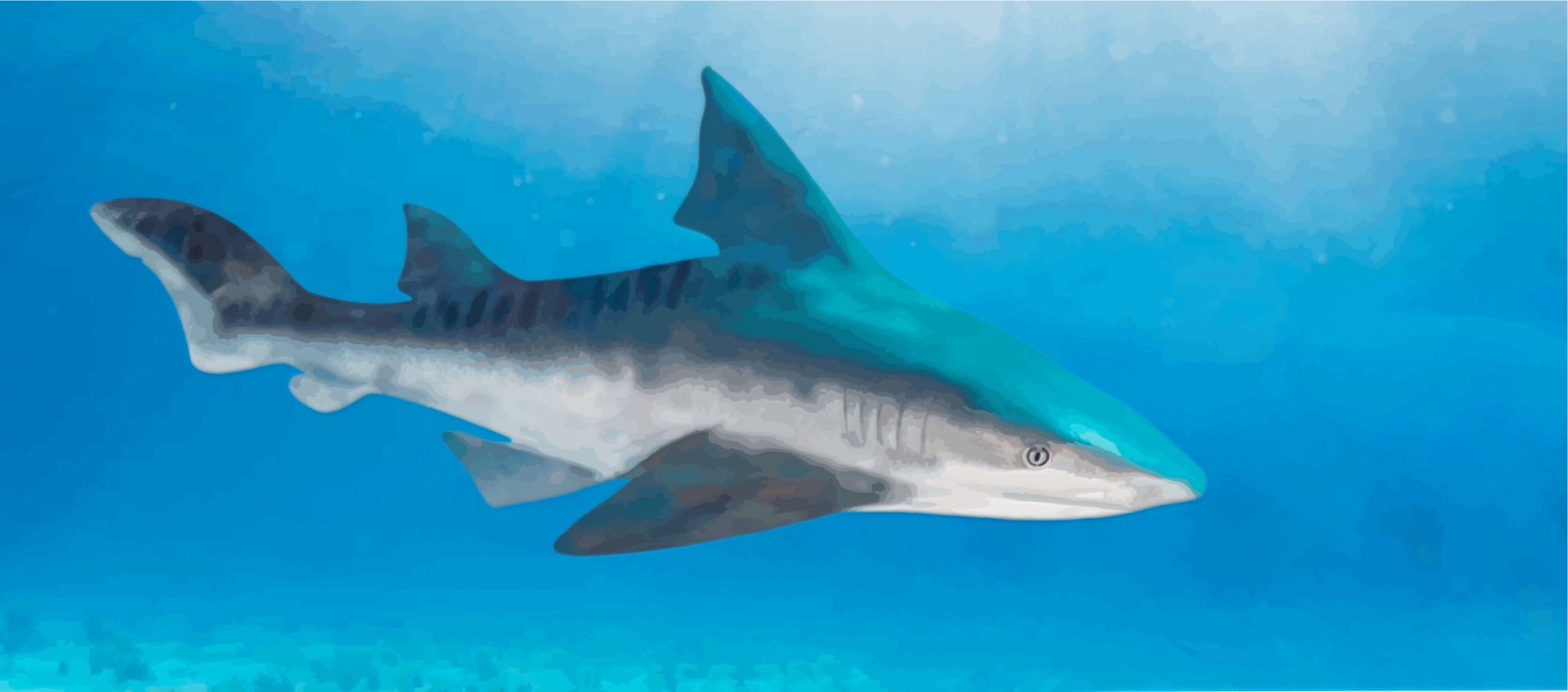
Lukeneder, A., Surmik, D., Gorzelak, P. et al. Bromalites from the Upper Triassic Polzberg section (Austria); insights into trophic interactions and food chains of the Polzberg palaeobiota. Scientific Reports 10, 20545 (2020)
Involved citizen scientists: Birgitt Aschauer and Karl Aschauer
Type of participation: collecting fossils, donating specimens to science

Lukeneder, A., Zverkov, N. 2020. First evidence of a conical-toothed pliosaurid (Reptilia, Sauropterygia) in the Hauterivian of the Northern Calcareous Alps, Austria. Cretaceous Research 106, February 2020, 104248
Involved citizen scientists: Karl Bösendorfer
Type of participation: reporting the locality, collecting fossils
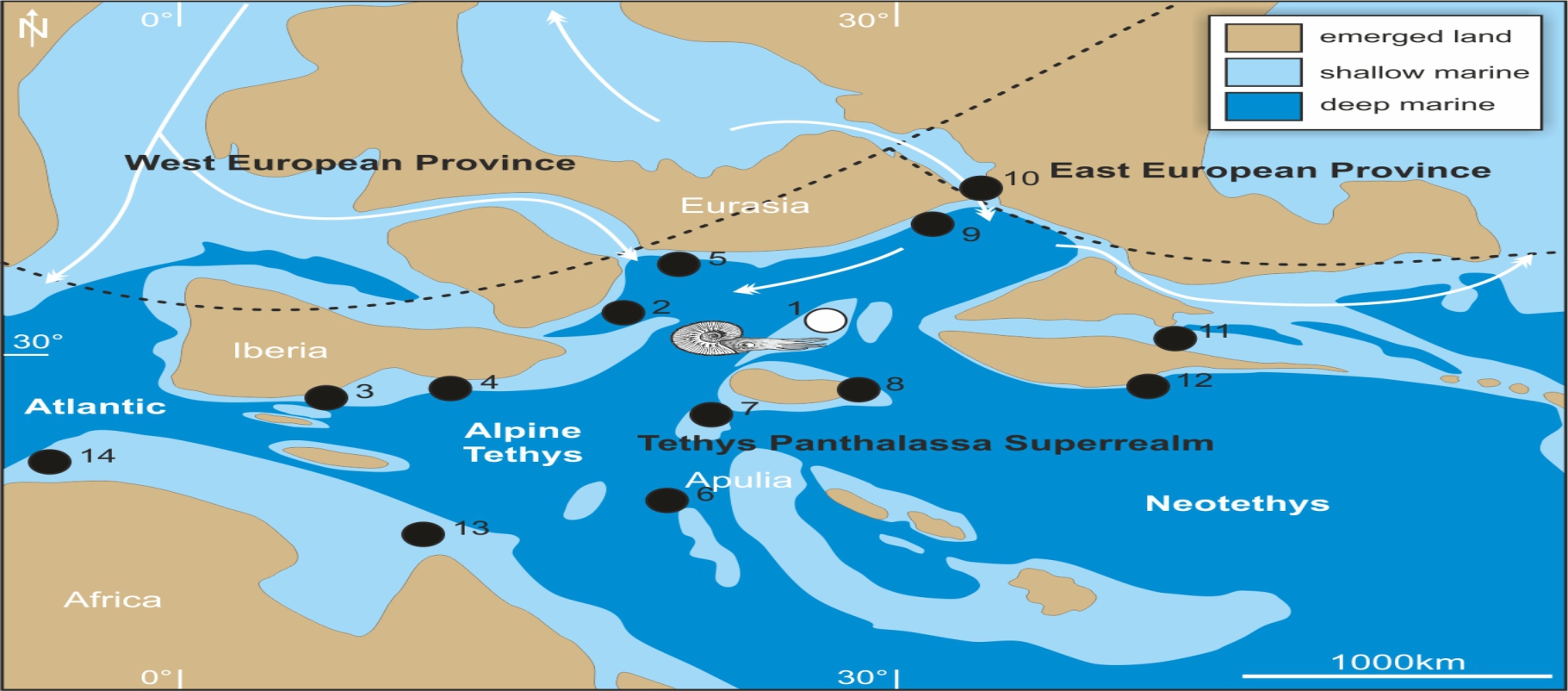
Lukeneder, A. 2018. A new ammonoid fauna from the Northern Calcareous Alps (upper Hauterivian–lower Barremian, Austria). Cretaceous Research, 88, 158-172.
Involved citizen scientists: Karl Bösendorfer
Type of participation: collecting fossils, donating specimens to science

Picture: (c) Alexander Lukeneder
Lukeneder, A., Lukeneder, P. 2022. Taphonomic history and trophic interactions of an ammonoid fauna from the Upper Triassic Polzberg palaeobiota. Scientific Reports, 12, 7455.
Involved citizen scientists: Birgitt and Karl Aschauer
Type of participation: donating specimens to science
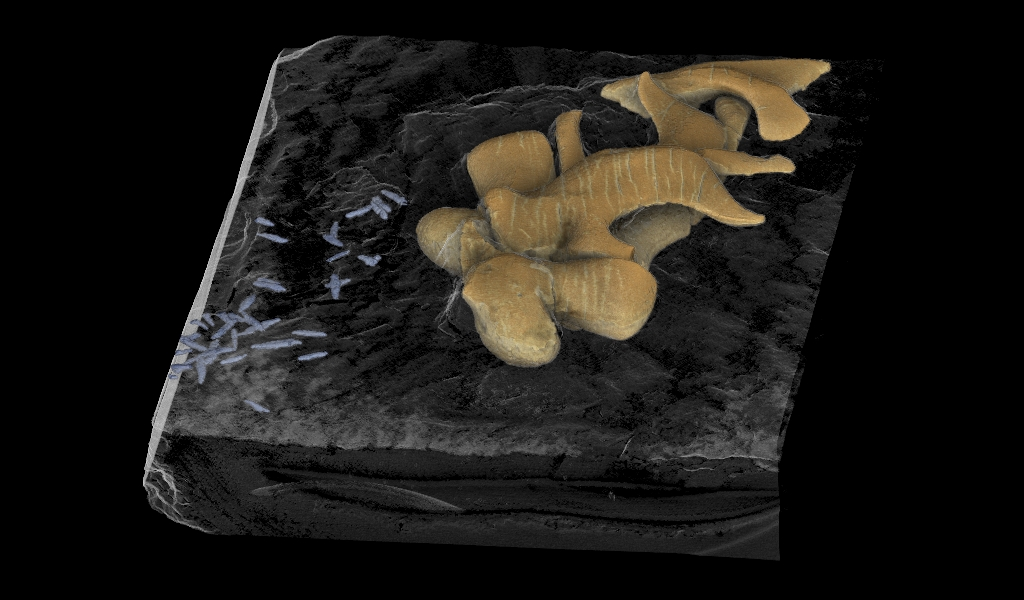
Picture: (c) Alexander and Petra Lukeneder
Lukeneder, P., Lukeneder A. 2022. Mineralized coleoid cranial cartilage from the Late Triassic Polzberg Konservat-Lagerstätte (Austria)". PLOS ONE, 17(4): e0264595.
Involved citizen scienctist: Birgitt and Karl Aschauer
Types of participation: donating specimens to science
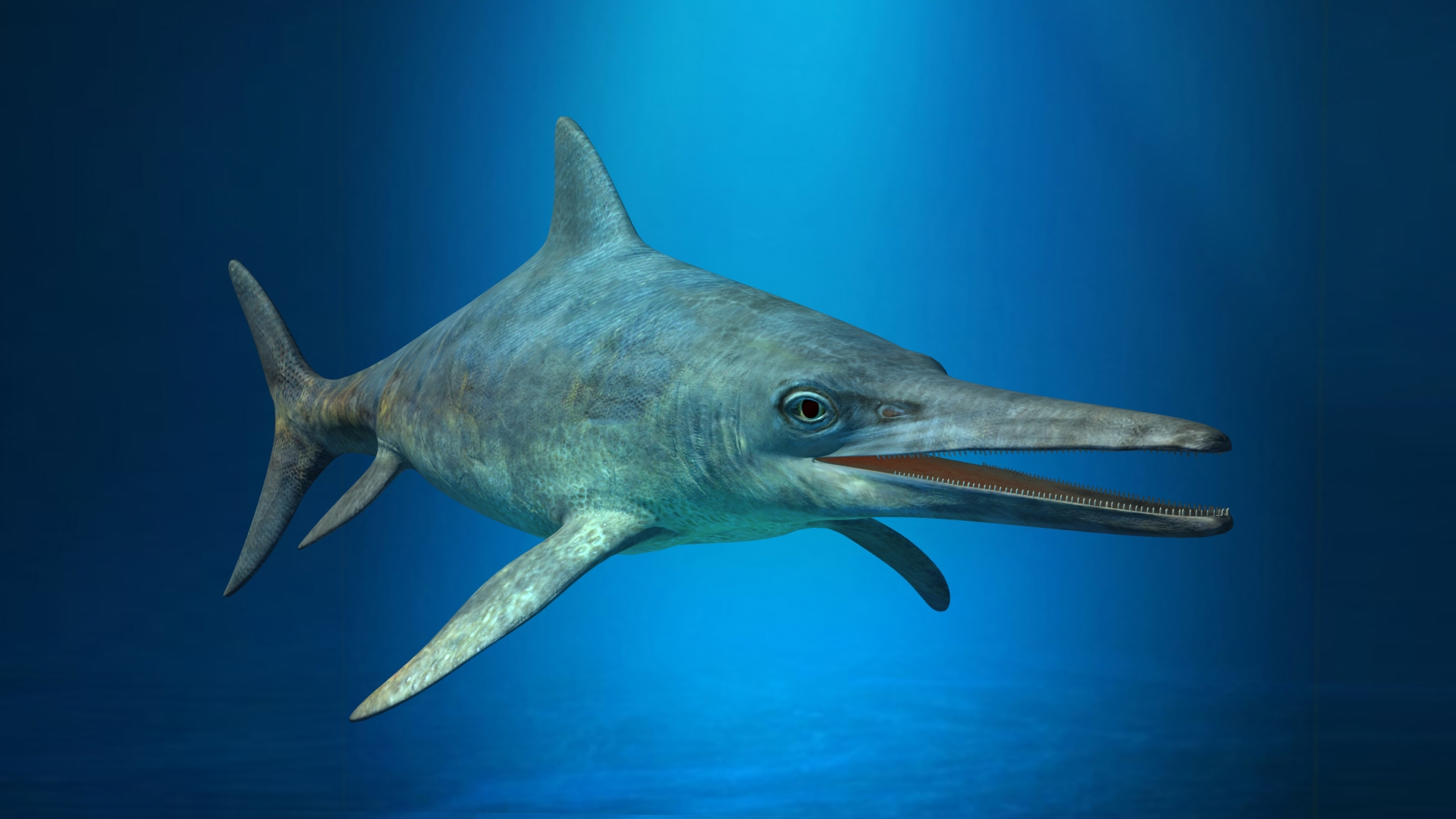
Picture: (c) Alexander Lukender, 7reasons
Lukeneder, A., Zverkov, N., Kaurin, C., Blüml, V. 2022. First Early Cretaceous ichthyosaurs of Austria and the problem of Jurassic–Cretaceous ichthyosaurian faunal turnover. Cretaceous Research, 136, 2022, 105224.
Involved citizen scientists: Karl Bösendorfer, Alfred Leiflfinger
Type of participation: collecting fossils, donating specimens to science

Picture: (c) Lukeneder, NHMW
Lukeneder, A., Lukeneder P. 2021. The Upper Triassic Polzberg palaeobiota from a marine Konservat-Lagerstätte deposited during the Carnian Pluvial Episode in Austria. Nature Research, Scientific Reports, 11, 16644 (2021).
Involved citizen scientists: Birgitt and Karl Aschauer
Types of participation: donating specimens to science
Interesting links
In the following you will find interesting internet links with Cretaceous period reference. On these pages citizen scientists can read the latest publications about fossils, environment or climate variations of the Cretaceous period. In addition, internationally and globally valid classifications and zonings of the Cretaceous can be viewed. Important data and facts for route planning and the localization of find points can be planned and retrieved in digital systems. Tectonic units and rock formations can be explored on geological maps.
All these data are freely accessible on the assigned links.
https://www.journals.elsevier.com/cretaceous-research
https://www.journals.elsevier.com/palaeogeography-palaeoclimatology-palaeoecology
http://www.austrianmap.at/amap/
https://www.kompass.de/wanderkarte/
https://www.geologie.ac.at/onlineshop/karten
https://fossils-of-austria.at/
Media
Citizen Science Seminar
In 2022, poject coordinator Alexander Lukeneder held a lecture about Fossilfinder as part of the lecture series "Citizen Science Seminar" at the University of Natural Resources and Life Sciences Vienna (BOKU): "Fossilfinder - to report or not to report, that is the question" (in German). Here, you can watch the video recording of the lecture on our YouTube-channel:
Pliosaurs in the Cretaceous Sea of Austria (in German)
Research in the Dolomites (in German)
Animation of the heteromorphours Cretaceous ammonite Dissimilites
Ammonite mass occurrences in Turkey
Science Talk - Mass extinction, swamp forests and flying fish of Lunz
First ichthyosaur record from the Cretaceous period in Austria
Topotheque
The growing flood of images cannot be processed by institutions alone. Partnership with citizen scientists is vital. Topotheque is a digital archive and network in which this historical legacy can be gathered. For the locally resident Topotheque users, every new image and new piece of information means a valuable building block with which they can document their regional history in more detail. Enthusiasm for the work with the Topotheques creates local archives that captures an interest that goes far beyond regional interest. This includes prop managers and costume designers on period films and scientists who can retrace the spread of a cattle breed in the 1930s. People have very often discovered a photo of a great-grandfather in the photos that were provided by a previously unknown person.
Realisation
The Topotheque is run by a municipality or an association. Volunteers and digital archivists at the Topotheque work on behalf of the municipality as links with the general public. Running a Topotheque is easy and the entry field on the administration user interface meets the international archive standard. Before the update was started, the Topotheque volunteers were introduced to the system in a two-hour training course using ICARUS. A Topotheque is usually opened at a locally organised event in which interested members of the public are presented with the Topotheque as a digital option to gather contemporary documents. Local museums and municipal archives often benefit from the Topotheque, as they can be sent originals. Similarly, memory institutions can take advantage of the Topotheque as a platform for their own inventories.
Dialogue counts
The Topotheque creates new groups of users. A Topotheque can not only answer questions about the history of a castle complex, but also provide quick information on the questions “What did the inn look like in the 1960s?” or “Are there photos of old innkeepers?”. Questions asked offhand, which often refer to details, can be answered. These questions are asked by a new and often younger userbase. To get in touch, you can ask the Topotheque a question, which can be answered directly through the website. This is because dialogue is the heart and soul of the Topotheque.
Expansion
The Topotheque was developed in an office in Wiener Neustadt. Based on the first “Prater” Topotheque as an example, municipalities in Lower Austria were the first to make private material about the community history available with the help of volunteers. The Topotheque was also well received in Upper Austria and implemented in a regional project as part of LEADER. The LEADER regions Weinviertel-Ost, Weinviertel Donauraum, Traunviertler Alpenvorland and Eferdingerland as well as other regions are using topotheques or preparing to use the Topothek. With Carinthia, where the Topothek was launched as a provincial project, the Topotheque is now being joined by a new province. In the “co:op” EU project, the topic of which is communication work in the archive, the Topotheque was established in seven other countries. Through the international archive platform ICARUS, the Lower Austria state archive joined as a scientific partner.
https://www.citizen-science.at/en/immerse/worldwide/author/934-florianheigl?start=130#sigProId0a0fa5221b
Fire Database
In the Institute of Silviculture at the BOKU University, the occurrence, spread, causes and characteristics of forest fires in Austria have been analysed as part of various research projects since 2008. The array stretches back over several decades and includes approximately 8,000 fires, more than 7,000 of which were categorised as forest fires. The majority of forest fires were recorded in spring and summer. Parts of Carinthia, Tyrol, Styria, and the southern regions of Lower Austria were comparably highly affected by forest fires. Most of the fires were caused by human actions. These were either direct, caused by an out-of-control fire, or indirect, e.g. by a carelessly discarded cigarette. In the summer months, fires caused by lightning also play a role as they make up 40 % of the total. Many forest fires are investigated in more detail as case studies in order to analyse fire behaviour, the mortality of individual trees affected and the regeneration of forests. Increased attention is also being paid to the processing of forest fires before the year 2000.
In spring 2013, the Institute of Silviculture created an online platform that enables easy collection and analysis of forest fires that is not dependent on systems. The “Fire Database” web GIS application is available for free and allows interested members of the public to scan forest fire incidents and create statistics or graphics. Similarly, current or past forest fires can be recorded through an online entry form.
Podcast episode
In June 2023, project coordinator Mortimer Müller was guest on the Österreich forscht podcast Wissen macht Leute - you can listen to the episode here (in German).
Citizen Science Seminar
In 2021, poject coordinator Harald Vacik held a lecture about "Fire Database" as part of the lecture series "Citizen Science Seminar" at BOKU University: "Challenges of forest fire research in the alpine region" (in German). At the bottom of this page you can watch the video recording of the lecture.
Links
- Forest Fire Database Austria
- Forest Fire blog Austria
- Forest fire research at BOKU
- European Forest Fire Information System (EFFIS)
-
 Cloud of smoke from the forest fire near Neunkirchen, Lower Austria, on 1st August 2013 Cloud of smoke from the forest fire near Neunkirchen, Lower Austria, on 1st August 2013
Cloud of smoke from the forest fire near Neunkirchen, Lower Austria, on 1st August 2013 Cloud of smoke from the forest fire near Neunkirchen, Lower Austria, on 1st August 2013 -
 Forest fire near Neunkirchen, Lower Austria, on 1st August 2013 Forest fire near Neunkirchen, Lower Austria, on 1st August 2013
Forest fire near Neunkirchen, Lower Austria, on 1st August 2013 Forest fire near Neunkirchen, Lower Austria, on 1st August 2013 -
 Damage caused by the forest fire near Neunkirchen (1) Damage caused by the forest fire near Neunkirchen (1)
Damage caused by the forest fire near Neunkirchen (1) Damage caused by the forest fire near Neunkirchen (1) -
 Damage caused by the forest fire near Neunkirchen (2) Damage caused by the forest fire near Neunkirchen (2)
Damage caused by the forest fire near Neunkirchen (2) Damage caused by the forest fire near Neunkirchen (2) -
 Damage caused by the forest fire near Neunkirchen (3) Damage caused by the forest fire near Neunkirchen (3)
Damage caused by the forest fire near Neunkirchen (3) Damage caused by the forest fire near Neunkirchen (3) -
 Damage caused by the forest fire near Neunkirchen (4) Damage caused by the forest fire near Neunkirchen (4)
Damage caused by the forest fire near Neunkirchen (4) Damage caused by the forest fire near Neunkirchen (4) -
 Number of forest fires 1994-2014 (reported via Fire-Database) Number of forest fires 1994-2014 (reported via Fire-Database)
Number of forest fires 1994-2014 (reported via Fire-Database) Number of forest fires 1994-2014 (reported via Fire-Database) -
 Distribution of forest fires over the year (totals from the years 1994-2014; reported via Fire-Database) Distribution of forest fires over the year (totals from the years 1994-2014; reported via Fire-Database)
Distribution of forest fires over the year (totals from the years 1994-2014; reported via Fire-Database) Distribution of forest fires over the year (totals from the years 1994-2014; reported via Fire-Database)
https://www.citizen-science.at/en/immerse/worldwide/author/934-florianheigl?start=130#sigProId9148f66075




